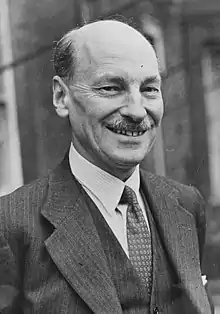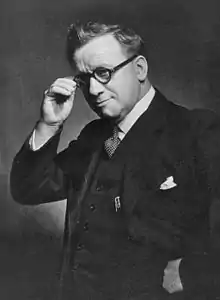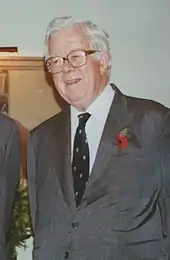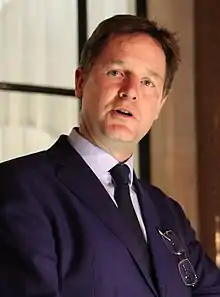Deputy Prime Minister of the United Kingdom
Deputy Prime Minister of the United Kingdom (DPM) is an office sometimes given to a cabinet minister in the Government of the United Kingdom.
| Deputy Prime Minister of the United Kingdom | |
|---|---|
.svg.png.webp) Royal Arms of Her Majesty's Government | |
Incumbent (Office not in use) (Vacant) since 8 May 2015 | |
| Government of the United Kingdom | |
| Style | Deputy Prime Minister (informal) The Right Honourable (UK and Commonwealth) |
| Status | Office not in Use (since 2015) |
| Member of | Cabinet Privy Council |
| Reports to | Prime Minister |
| Residence | None, may use Grace and favour residences |
| Seat | Westminster, London |
| Appointer | The Monarch on advice of the Prime Minister |
| Term length | No fixed term |
| Formation | 19 February 1942 |
| First holder | Clement Attlee |
| Website | www.gov.uk |
| This article is part of a series on |
| Politics of the United Kingdom |
|---|
.svg.png.webp) |
|
|
The office is not always in use and Prime Ministers may use other offices, such as First Secretary of State, to give seniority to a particular cabinet minister. Indeed, the office is currently not in use and Dominic Raab is the present First Secretary.
Constititional position
Unlike analogous offices in some other nations, such as the Vice President of the United States or Tánaiste, the Deputy Prime Minister has no automatic salary[1] and no right to automatic succession.[2] Theoretically, the sovereign possesses the unrestricted right to choose someone to form a government following the death, resignation or dismissal of a Prime Minister.[3] One argument made against appointing someone to the office is that it might restrict the royal prerogative to choose a Prime Minister.[4]
Rodney Brazier has said that there are three reasons why a Deputy Prime Minister has been appointed: to set out the line of succession to the premiership preferred by the Prime Minister, to promote the efficient discharge of government business and (in the case of Labour governments) to accord recognition to the status of the deputy leader of the Labour party.[4]
In the coalition governments of both Winston Churchill and David Cameron, the leader of a smaller party was also given the office of Deputy Prime Minister: Clement Attlee and Nick Clegg, respectively.[5]
When the office has been used in the past, the Deputy Prime Minister has deputised for the Prime Minister at official functions, such as Prime Minister's Questions.[6]
Unofficial deputies
Because they are seen to represent the Prime Minister's deputy, some journalists and others may informally refer to the First Secretary or other senior ministers as the deputy Prime Minister.
Rodney Brazier lists 14 unambigious deputies to the Prime Minister since 1940, most of whom were never formally appointed Deputy Prime Minister.[5] These include First Secretary Dominic Raab under the current Prime Minister, Boris Johnson, and Willie Whitelaw under Margaret Thatcher, until 1988.[5]
History
The Deputy Prime Ministership, where it exists, may bring with it practical influence depending on the status of the holder, rather than the status of the position.
Labour Party leader Clement Attlee held the post in the wartime coalition government led by Winston Churchill, and had general responsibility for domestic affairs, allowing Churchill to concentrate on the war. Rab Butler held the post in 1962–63 under Harold Macmillan, but was passed over for the premiership in favour of Alec Douglas-Home.
During Edward Heath's government (1970–1974), the office of Deputy Prime Minister was not formally used. However, in his Memoirs, Home Secretary Reginald Maudling described himself as Deputy Prime Minister under Heath from 1970 to his resignation in 1972 over the Poulson affair. William Armstrong, head of the Civil Service, was also called Heath's Deputy Prime Minister.[7] The Deputy Leader of the Labour Party, Ted Short, was Leader of the House of Commons from 1974 to 1976 under Harold Wilson and often thought of as Deputy Prime Minister; he was referred to as such in the citation for being made an Honorary Freeman of the City of Newcastle upon Tyne.
William Whitelaw was Margaret Thatcher's de facto deputy from 1979–1988,[8] an unofficial position he combined with that of Home Secretary in 1979–1983 and Leader of the House of Lords after 1983. Sir Geoffrey Howe was bestowed the office of Deputy Prime Minister by Thatcher in 1989,[8] on being removed from the post of Foreign Secretary. He resigned as her deputy in 1990, making a resignation speech that is widely thought to have hastened Thatcher's downfall. Thatcher's successor John Major did not appoint a Deputy Prime Minister until 1995, when Michael Heseltine was given the office.
John Prescott, who was elected Deputy Leader of the Labour Party in opposition, was appointed Deputy Prime Minister by Tony Blair in 1997, in addition to being Secretary of State for the Environment, Transport and the Regions. In 2001 this "superdepartment" was split up, with Prescott being given his own Office of the Deputy Prime Minister with fewer specific responsibilities. In May 2006, the department was removed from the control of the Deputy Prime Minister and renamed as the Department for Communities and Local Government with Ruth Kelly as the Secretary of State for Communities and Local Government.
Following the 2010 general election, which returned a hung parliament, the Conservatives and Liberal Democrats agreed to form a coalition government. As leader of the smaller of the two parties in the coalition, Nick Clegg was appointed Deputy Prime Minister on the advice of the new Prime Minister, Conservative leader David Cameron. During the coalition William Hague was appointed by Cameron as First Secretary of State, the only time that both positions have existed concurrently but been held by different people. As the position of Deputy Prime Minister would not entitle Clegg to a ministerial salary he was also appointed to the sinecure position of Lord President of the Council.
Clegg was the last person to officially hold the post as, following the subsequent 2015 election, in which the Conservatives won an overall majority in the House of Commons, Cameron decided not to appoint a replacement. He chose instead to appoint the Chancellor of the Exchequer George Osborne as First Secretary of State— effectively his deputy. After the 2016 referendum on European Union membership, and David Cameron's subsequent resignation, his successor as Prime Minister, Theresa May, also chose not to appoint an individual to either position. Following the 2017 snap general election, May again did not appoint a Deputy Prime Minister but did appoint Damian Green as First Secretary of State.[9]
After Green's resignation in 2017, the de facto Deputy Prime Minister function and responsibility was carried out by David Lidington in the office as Minister for the Cabinet Office, before passing to new First Secretary of State Dominic Raab in 2019.
Office and residence
There is no set of offices permanently ready to house the Deputy Prime Minister.[10] The most recent Deputy Prime Minister, Nick Clegg, maintained an office at the Cabinet Office headquarters, 70 Whitehall, which is linked to 10 Downing Street.[11] Clegg's predecessor, John Prescott, maintained his main office at 26 Whitehall.[12]
The Prime Minister will also give them the use of a grace and favour country house.[10] While in office, Nick Clegg resided at his private residence in Putney and he shared Chevening House with First Secretary William Hague as a weekend residence.[13] Clegg's predecessor, John Prescott, used Dorneywood.[10]
List of Deputy Prime Ministers
| Name | Picture | Term of office | Party | Ministerial office(s) | PM | |||
|---|---|---|---|---|---|---|---|---|
| Clement Attlee |  |
19 February 1942 | 23 May 1945 | Labour (Leader)[note 1] |
|
Churchill (Coalition) | ||
| Herbert Morrison |  |
26 July 1945 | 26 October 1951 | Labour (Deputy Leader) |
|
Attlee (I & II) | ||
| Anthony Eden | .jpg.webp) |
26 October 1951 | 6 April 1955 | Conservative | Churchill (III) | |||
| Office not in use | 1955–1962 | N/A | Eden | |||||
| Macmillan | ||||||||
| Rab Butler |  |
13 July 1962 | 18 October 1963 | Conservative | ||||
| Office not in use | 1963–1989[note 2] | N/A | Home | |||||
| Wilson | ||||||||
| Heath | ||||||||
| Wilson | ||||||||
| Callaghan | ||||||||
| Thatcher | ||||||||
| Geoffrey Howe |  |
24 July 1989 | 1 November 1990 | Conservative | ||||
| Office not in use | 1990–1995 | N/A | Major | |||||
| Michael Heseltine | .jpg.webp) |
20 July 1995 | 2 May 1997 | Conservative | ||||
| John Prescott |  |
2 May 1997 | 27 June 2007 | Labour (Deputy Leader) |
|
Blair | ||
| Office not in use | 2007–2010 | N/A | Brown | |||||
| Nick Clegg |  |
11 May 2010 | 8 May 2015 | Liberal Democrats (Leader)[note 1] |
|
Cameron (Coalition) | ||
| Office not in use | 2015–present | N/A | Cameron (Majority) | |||||
| May | ||||||||
| Johnson | ||||||||
Timeline

See also
Footnotes
- Leader of the junior party in a coalition government.
- William Whitelaw, 1st Viscount Whitelaw served as deputy leader of the Conservative Party under Thatcher and Major from 1975 to 1991. Although he served in cabinet from 1979 to 1988 he never officially acquired the title of Deputy Prime Minister. The Deputy Leaders of the Labour Party when Labour was in office during this period too did not hold the title of Deputy Prime Minister.[8]
References
- Ministerial and other Salaries Act 1975 Sch 1.
- The Cabinet Manual. 2010. p. 22.
- Stanley de Smith and Rodney Brazier, Constitutional and Administrative Law (Penguin, 1989) p.116.
- Brazier, Rodney (1988). "The deputy prime minister". Public Law: 176.
- Brazier, Rodney (2020). Choosing a prime minister : the transfer of power in Britain (First ed.). Oxford, United Kingdom. pp. 80–2. ISBN 978-0-19-260307-4. OCLC 1182632161.
- Priddy, Sarah (30 April 2020). "Attendance of the Prime Minister at Prime Minister's Questions (PMQs) since 1979". House of Commons Library.
- Ziegler, Philip. "How the last Tory-Liberal deal fell apart" The Sunday Times, 9 May 2010.
- Hennessy, Peter (2001). "A Tigress Surrounded by Hamsters: Margaret Thatcher, 1979–90". The Prime Minister: The Office and Its Holders since 1945. Penguin Group. ISBN 978-0-14-028393-8.
- Stewart, Heather. "Theresa May appoints close ally Damian Green as first secretary of state". The Guardian. Retrieved 11 June 2017.
- Brazier, Rodney (2020). Choosing a Prime Minister: the Transfer of Power in Britain (First ed.). Oxford, United Kingdom: Oxford University Press. p. 73. ISBN 978-0-19-260307-4. OCLC 1182632161.
- "Nick Clegg could be given use of stately home where John Prescott played croquet". Telegraph. 13 May 2010. Retrieved 22 May 2010.
- "Deputy Prime Minister | Contact us". Archive.cabinetoffice.gov.uk. Archived from the original on 16 May 2010. Retrieved 22 May 2010.
- "Hague and Clegg given timeshare of official residence". BBC News. 18 May 2010. Retrieved 22 May 2010.
- Clegg To Be Cameron's Deputy In New Cabinet Sky News Archived 15 May 2010 at the Wayback Machine
- "Lib Dem leader Nick Clegg to be deputy PM". Reuters. 12 May 2010.
